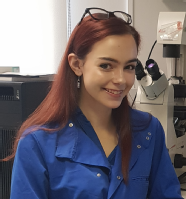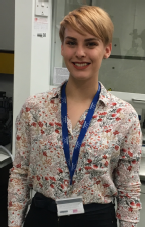Current Students
2021/22 Cohort

Serena Thomas
Formation of skeletal muscle during development is a process that is as reliant on genetics and biochemistry as it is biomechanical and physical forces. During development mononucleate, precursor muscle cells known as myocytes fuse to form a large, multinucleate cell known as a myotube, which elongates as it matures into a myofibre – the core cell type of skeletal muscle. Microtubules – a core component of the cytoskeleton – are thought to play a significant role in these processes, and in the processes of moving and spreading the nuclei within the myotube, disruption of which can result in certain types of Muscular Dystrophies. My PhD will explore the role of microtubules in the processes of in vivo muscle morphogenesis as well as exploring their role in distributing and shaping myotube nuclei. I will be using Zebrafish as a model organism for my studies, utilising a variety of approaches including transgenics, advanced microscopy, and computational analysis to achieve an understanding of the role of Microtubules in the spatiotemporal dynamics of myotome development.

Molly Watling
Traditional methods of RNA imaging such as FISH or molecular beacons require fixation and addition of exogenous probes. Genetically encoded light-up RNA aptamers offer a promising alternative. Light-up aptamers are short oligonucleotides that bind conditionally fluorescent probes, providing low background and high signal-to-noise ratio. The increasing frequency and magnitude of viral outbreaks in recent decades, epitomized by the current COVID-19 pandemic, has resulted in an urgent need for new ways to study virus-host interactions. My project aims to develop, in vitro RNA labelling methods using light-up aptamers. I also aim to define the precise locations and components of viral replication sites in cells and understand how and where virus assembly takes place, information that is vital to combating viral disease.

Macarius Howard
Antimicrobial resistance, a forever increasing global health risk. Bacteria have acquired resistance to a multitude of antibiotic treatments, some strains are completely resistant to all known antibiotics. Rapid reproductive rates in conjunction with the mis-use of antibiotics are responsible for the exponential antibiotic resistance observed. The majority of the WHO list of bacteria are Gram negative pathogens. Gram negatives generally more resistant due to their structure. Although there is a lot of research on phospholipid trafficking, the relatively less studied aminolipids could hold a key to this larger problem. My project aims to systematically mutant genes involved with phospholipid trafficking in order to define the role of Tol-Pal, Mla and Pqi in aminolipid trafficking and to determine the role of lipid trafficking on biogenesis of outer membrane proteins. In the hopes of observing how aminolipids modulate membrane asymmetry in Gram negatives.

Priya Dhami
Endometriosis is a chronic inflammatory disorder affecting approximately 10% of women of reproductive age worldwide. It is characterised by the growth of endometrial-like tissue known as lesions outside the uterus, in places such as the lower abdomen and pelvic cavity. The aetiology of endometriosis has not been clearly defined, but it is known that macrophages are central in the pathophysiology and maintenance of endometriosis lesions. My PhD will explore the ontogeny of macrophages within the endometrium and endometriosis. I will utilise a genetically modified mouse model of induced endometriosis to enable macrophage fate mapping. Determining how origin impacts macrophage phenotype in endometriosis will enable us to understand and predict which macrophage subsets contribute to disease pathogenesis and progression.
2020/21 Cohort

Julia Saez Conde
My PhD research focuses on the function of the ciliary transition zone in a protozoan and an animal system. I will investigate the human pathogen Trypanosoma brucei, a parasitic kinetoplastid best known for causing sleeping sickness as a protozoan model, and zebrafish as an animal model. Several lines of evidence suggest that a protein called ODF3 in humans plays an important role in ciliary function. The focus of the project is to study ODF3 in zebrafish, its ortholog in trypanosomes TZP250, and their role in genetic and infectious disease.

Kavana Bywater-Brenna
Cloisteroides difficile (C. difficile) is an opportunistic spore-forming anaerobic bacterium, and C. difficile infection (CDI) is one of the leading causes of health-care associated diarrhoea. CDI can manifest differently, ranging from an asymptomatic carrier state, to varying severities of diarrhoea and pseudomembranous colitis and, in more severe cases, to toxic megacolon and ultimately death. As such, CDI is considered to be one of the most significant nosocomial infections of our time. Although considered part of the normal gut microflora, C. difficile is not normally problematic in healthy individuals. Imbalances in host-microbiome relationships often caused by antibiotic-mediated gut dysbiosis, can lead to C. difficile proliferation and subsequent infection.To date, the interactions occurring between various commensals, the host gut epithelium, and C. difficile have yet to be systematically characterised. My PhD project seeks to investigate such host-microbiome interactions and their impact on pathogen colonisation, using metatranscriptomics. It is hoped that this will provide further insight not only into the complex dialogue that occurs between commensals and the host, but also into key pathways that are modulated during C. difficile infection.

Nimo Abdullah
My project aims to identify novel regulators of Aurora B kinase by Genome-Wide CRISPR/Cas9 screen. Aurora B kinase is a key regulator in mitosis and involved in many processes to ensure successful cell division. Various abnormalities of Aurora B have been associated with cancer. However, Aurora B’s regulation in mitosis is not yet fully understood. The identification and characterisation of novel Aurora B regulators can thus provide insights on the regulation of Aurora B in mitosis and provide potential drug targets for cancer chemotherapy.

Tom Davies
Flagella are nanomachines primarily used by bacteria for chemotaxis and motility. They are multifunctional sensory organelles that contain a supramolecular motor mediated by electrochemical gradients and ATP. Considerable research has been conducted into elucidating the formation and regulation of bacterial flagella, however, there are still many aspects that remain poorly understood. My research will focus on the assembly of flagella in the lipid membrane of the amphitrichous bacteria Campylobacter jejuni (C. jejuni). By applying multifaceted laboratory techniques (cryo-EM, protein crystallography, computational protein modelling), I aim to explain the spatial and temporal mediation of flagella composition and regulation. I will be focusing on the conformation and interaction of three critical proteins; fliH; fliI and fliJ that form the putative ATP-ase protein export system of C. jejuni flagella.
2019/20 Cohort

Edgar Polovinkins
In my PhD, I will be looking at an essential RNA-binding protein Ybx1 which has a critical role in translation. The protein has also been linked to tumorigenesis and elevated levels are a factor in cancer progression. Currently only the Cold shock domain (CSD) of the protein has been studied extensively, however the unstructured C-terminus domain (CTD) also plays a role in binding. I will be investigating how the full-length protein interacts with RNA and the way binding affinity is influenced by the RNA structure. My project will show how the flanking regions around CSD, in Ybx1, affect binding and the importance of the C-terminus domain, uncovering the way CSD protein are able to select RNA targets by utilising the whole protein. Molecular and structural biology will be employed in this project to crystallise the protein and mutate key residues.

Jack Petts-Lewis
The project focuses on genetic regulation in the formation of the anterior neural plate (ANP) during early embryonic zebrafish development. Capitalising on recent developments in imaging technology, a spatial and temporal map of transcriptome-wide gene expression during ANP development will be discerned, with the aim of linking genetic regulation to mechanical mechanisms of morphogenesis in this tissue with highly complex and specific shaping and patterning.

Paulina Pokorska
The aim of my PhD project is to provide the first complete evaluation of a hybrid cell-cell adhesion system for macrophage migration, which will allow a new avenue to study how adhesion complexes evolve over time, their plasticity and how they are affected by the substrate’s mechanical properties and biochemical composition. The expected results will provide major advances in our understanding of the dynamic regulation of cell-cell adhesions and molecular details of a process integral for immune system development and function.

Jack Cooper
Collective cell migration is an essential feature of developmental processes such as tissue morphogenesis, and plays an important role during tumour invasion. Several invading cancers mimic molecular mechanisms used by collectively migrating embryonic cells. I will be researching whether embryonic macrophages in Drosophila melanogaster migrate collectively, and whether their migration is guided by mechanical cues such as substrate stiffness
2018/19 Cohort
Dagnija Tupiņa
In my PhD project I will investigate the relationship between flagella component expression regulation and flagella motor assembly in Campylobacter jejuni. Molecular biology, cryo-tomography and computational methods will be employed to investigate how flagella components interact and assemble to form the flagella rotor and explore the connection between structural and regulatory processes. C.jejuni is an amphitrichous model organism unlike more widely characterized bacterial model organisms and may unveil new details about flagella assembly and positioning.
Amy Milne
My research focusses on probing the molecular mechanisms of mycobacterial survival within the bone, specifically mycobacterium tuberculosis. Much about the pathogenesis of skeletal tuberculosis remains unclear. Therefore, my PhD aims to identify the genes required for invasion and survival within bone cells using cutting edge molecular and cellular technologies. Key proteins involved may be suitable targets for novel treatments and could be early markers for diagnosis, improving treatment outcomes.
Sarah Harden
Stromal cells in the inner most lining of the uterus, the endometrium, transform into specialised decidual cells in preparation for pregnancy. Interestingly, this process, decidualization, is specific to 1.5% of mammals including humans. My PhD is focussed on studying metabolites secreted by the cells, the exometabolome, and how this connects to epigenetic regulation during decidualization. This will be beneficial in understanding the interplay between the metabolism and epigenetic regulation in the endometrium.
Lucia Brown
My research focusses on studying individualised anti-cancer drug susceptibility and metastatic profiling of human cancers via the development of modular, integrated microfluidic platforms. I am interested in the modulation of drug response by the tumour microenvironment and how this can be interrogated to better inform the treatment of solid tumours. Within our lab we aim to create solutions that will improve the translational efficacy of in vitro laboratory-based research to clinical settings. I aim to achieve this by developing a microfluidic device that is compatible with commercially available microplate readers, which will allow for the relatively rapid evaluation of traits that contribute to drug resistance and sensitisation. This allows for the construction of a resistance ‘profile’ which can be used to augment pre-existing clinical information to determine the most appropriate modes of patient management and anticipate their probability of success.
Esther Ivorra Molla
Hedgehog (Hh) is a signal peptide involved in tissue patterning during embryogenesis and stem cells regulation in adults. Missregulation of Hedgehog pathway may lead to developmental defects and apparition of different types of cancer such as Basal Cell Carcinoma.
The aim of my project is to study the interaction sites between the signal peptide Hedgehog and its receptor Patched by using genetic-code expansion technology. This will be helpful to understand how to modulate this pathway and restore its normal activity in Hedgehog or Patched defective mutants.
2017/18 Cohort
Ewan Stephenson
My PhD project is centred on the interplay between the molecular circadian clock and cancer cells. The molecular clockwork, with which our cells anticipate the geophysical day, is exquisitely important for cellular function. This mechanism tends to be modified in a number of cancer types. I will attempt to understand better the reason for this modification with molecular biology techniques such as CRISPR.
Poonam Shah
My project is on membrane trafficking, supervised by Steve Royle and Fred Bard. I will be working on a novel endocytic pathway in which vesicles, termed Nuclear-Envelope Associated endosomes (NAEs), translocate directly from the plasma membrane to the nucleus. They fuse with the nuclear envelope and discharge their contents into the nucleoplasm. I will be using techniques such as confocal live cell imaging to characterise NAEs, the pathway they take to the nucleus, and the interactions between NAEs and the nuclear envelope.

Max Addison
Photorhabdus is a bacterial symbiont of insect pathogenic nematodes, which is used by the nematodes to disable the immune system, kill and sterilize its hosts. Photorhabdus produces a wide array of toxins and secondary metabolites to achieve this, including some novel antibiotics. Some Photorhabdus species can also infect humans causing large lesions that spread across the body, but little is known about it and cases are currently isolated to Australia and the USA.
My project is to investigate and re-engineer toxin delivery system Photorhabdus produces known as a PVC. This delivery system acts like a headless bacteriophage, binding selectively to the target cell and injecting a payload most typically a toxin. Part of my project is to see if it is possible to change the target specificity of the PVCs and change what payload they are delivering. I am also investigating the native toxins associated with PVCs, and what implications they may have in the human infective cases.

Finnlay Lambert
Summary: My project aims to study RNA structure through both chemical probing and functional assays. RNA, previously thought of as a passive messenger, has now been shown to have many important roles in gene regulation. This effect is not just limited to sequence but also the secondary structure of RNAs. The Sampath lab (University of Warwick) has previously demonstrated a shared sequence and structure motif, found across various transcripts of the NODAL pathway, to be essential for early development of the Zebrafish (Danio rerio). The Yue Wan lab (A*STAR Genome Institute of Singapore) develops techniques used to study RNA structure at the ‘omics’ scale. My current work focuses on determining the in vitro structure by chemical probing of known RNAs with secondary structure. I am also looking to optimise techniques such as Nanopore sequencing for studying RNA structure in yeast and mammalian cells, to be transferred to study developing Zebrafish.







